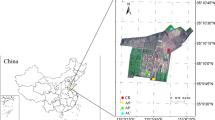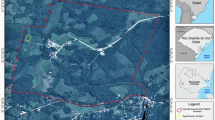Abstract
Land degradation and the associated soil acidity are critical challenge for crop production in Ethiopian highlands. Since liming is expensive, farmers have developed an alternative agroforestry system by integrating Acacia decurrens into their landscapes. The expansion rate of this system was assessed over the last three decades. The effects of the agroforestry system and charcoal-making kiln sites on soil properties were investigated for over five years compared to the adjacent croplands. Soil samples were collected from A. decurrens plantations, kiln sites, and adjacent croplands at 0–15 and 15–30 cm soil depths. In the last 30 years, the plantation and croplands increased by 8% and 17.5%, respectively, compared to the land-use system in 1993, mainly at the expense of grassland and abandoned land. The main incentive for expansion of A. decurrens plantations was farmers’ income generated from charcoal making. This intervention also improved soil properties with a significantly positive effect on soil pH, soil organic carbon (SOC), cation exchange capacity (CEC), and available Bray phosphorus (Bray-P) compared to the adjacent croplands. Results revealed that the SOC content in year 2 increased significantly (1.3–1.7 times) under A. decurrens plantation compared to adjacent crop fields. Moreover, soil pH increased by one unit on charcoal-making fields, which was equivalent to application of 4–5 t lime ha−1, while SOC increased by ~ 10% on kiln sites compared to the control. Charcoal making kiln spots increased available soil phosphorus by 112% compared to the adjacent non-kiln sites. The Bray- P was strongly and significantly (P < 0.05) correlated (r = 0.75) with soil pH. We conclude that integrating A. decurrens-based agroforestry practices would improve livelihoods by restoring degraded lands, improving income generation and carbon sequestration.





Similar content being viewed by others
References
Abate BA, Wossen BA, Degfie TT (2016) Determinants of intimate partner violence during pregnancy among married women in Abay Chomen district, Western Ethiopia: a community based cross sectional study. BMC Womens Health 16:16
Abate E, Hussein S, Laing M, Mengistu F (2017) Soil acidity under multiple land-uses: assessment of perceived causes and indicators, and nutrient dynamics in small-holders’ mixed-farming system of northwest Ethiopia. Acta Agriculturae Scandinavica, Section B—Soil & Plant Science 67:134–147
Abebe M (2007) Nature and management of acid soils in Ethiopia. Haramaya University, Haramaya, Ethiopia, p 99
Adam JC (2009) Improved and more environmentally friendly charcoal production system using a low-cost retort–kiln (Eco-charcoal). Renewable Energy 34:1923–1925
Agegnehu G (2018) Soil fertility and crop management research on cool-season food legumes in the central highlands of Ethiopia. Ethiopian J Agricul Sci 28:95–109
Agegnehu G, Amede T (2017) Integrated soil fertility and plant nutrient management in tropical agro-ecosystems: a review. Pedosphere 27:662–680
Agegnehu G, Yirga C, Warner J (2018) Soil acidity in ethiopia: Causes, effects, management and policy consideration (IFPRI). International Food Policy Research Institute, Addis Ababa, Ethiopia
Amede T, Taboge E (2007) Optimizing soil fertility gradients in the enset (Ensete ventricosum) label chapter 26 systems of the Ethiopian highlands: Trade-offs and local innovations. Advances in integrated soil fertility management in Sub-Saharan Africa: Challenges and opportunities, Springer, pp 289–297
Amede T, Belachew T, Geta E (2001) Reversing the degradation of arable land in the Ethiopian highlands. In “Managing Africa’s Soils”, pp. 1–29, Addis Ababa, Ethiopia
Amede T, Van den Akker E, Berdel W, Keller C, Tilahun G, Dejen A, Legesse G, Abebe H (2020) Facilitating livelihoods diversification through flood-based land restoration in pastoral systems of Afar, Ethiopia. Renewable Agriculture and Food Systems: 1–12
Amede T, Kirkby RA (2004) Guidelines for integration of legumes into the farming systems of East African highlands. In: Bationo A (ed) Managing nutrient cycles to sustain soil fertility in Sub-Saharan Africa. Academy Science Publishers (ASP), Nairobi, pp 43–64
Barber S, Mackay A, Kuchenbuch R, Barraclough P (1988) Effects of soil temperature and water on maize root growth. Plant Soil 111:267–269
Brown R (2009) Biochar production technology. Biochar for environmental management: Sci Technol. 127–146
Demil A, Amare T, Awoke Y, Derebe A, Adera T (2020) Bridging the yield gaps of bread wheat at a scale through an innovative method of lime application in the acidic soils of Northwestern Ethiopia. Cogent Food & Agriculture 6:1–25
Dessie AB, Abate TM, Mekie TM (2019) Eucalyptus: the popular exotic tree crop in Ethiopia. Acta Scientific Agriculture 3(9):50–56
Duncan MR (2002) Soil acidity and P deficiency: Management strategies for the northern Tablelands of New South Wales (NSW). NSW Agriculture, Armidale, Australia
Edwards C, Arancon N (2004) Interactions among organic matter, earthworms and microorganisms in promoting plant growth. In: Magdoff F, Weil R (Eds.). Functions and management of organic matter in agroecosystems. CRC Press. Boca Raton, FL
Fageria NK, Nascente AS (2014) Management of soil acidity of South American soils for sustainable crop production. Adv Agron 128:221–275
Glaser B, Lehmann J, Zech W (2002) Ameliorating physical and chemical properties of highly weathered soils in the tropics with charcoal–a review. Biol Fert Soils 35:219–230
Golla AS (2019) Soil acidity and its management options in Ethiopia: a review. Int J Scient Res Manag 7:2321–3418
Goulding K (2016) Soil acidification and the importance of liming agricultural soils with particular reference to the United Kingdom. Soil Use Manag 32:390–399
Haile W, Boke S (2009) Mitigation of soil acidity and fertility decline: Challenges for sustainable livelihood improvement: Evidence from southern region of Ethiopia. Sustainable land management and poverty alleviation Ethiopian Development Research Institute, Addis Ababa, pp 131–143
Hakim L, Miyakawa H (2015) Exotic plant species in the restoration project area in Ranupani recreation forest, Bromo Tengger Semeru Na-tional Park (Indonesia). Biodiv J 6:831–836
Hurni K, Zeleke G, Kassie M, Tegegne B, Kassawmar T, Teferi E, Moges A, Tadesse D, Ahmed M, Degu Y (2015) Soil degradation and sustainable land management in the rainfed agricultural areas of Ethiopia: an assessment of the economic implications. Report for the economics of land degradation initiative
Kitur B, Frye W (1983) Effects of heating on soil chemical properties and growth and nutrient composition of corn and millet. Soil Sci Soc Am J 47:91–94
Lehmann CJ, Rondon M (2006) Biochar soil management on highly-weathered soils in the tropics. In: Uphoff NT (ed) Biological Approaches to Sustainable Soil Systems. CRC Press, Boca Raton, pp 517–530
Lehtonen A, Ťupek B, Nieminen TM, Balázs A, Anjulo A, Teshome M, Tiruneh Y, Alm J (2020) Soil carbon stocks in Ethiopian forests and estimations of their future development under different forest use scenarios. Land Degradation Development: 1–12
Mekonnen K (2007) Evaluation of selected indigenous and exotic tree and shrub species for soil fertility improvement and fodder production in the highland areas of western Shewa, Ethiopia. University of Natural Resources and Applied Life Sciences, Vienna. http://hdl.handle.net/123456789/1870: (accessed in 15 April 2020)
Moritsuka N, Yanai J, Kosaki T (2001) Effect of soil heating on the dynamics of soil available nutrients in the rhizosphere. Soil Sci Plant Nutrition 47:323–331
Neary DG, Ryan KC, DeBano LF (2005) Wildland fire in ecosystems: effects of fire on soils and water. Gen Tech Rep RMRS-GTR-42-vol 4 Ogden, UT: US Department of Agriculture, Forest Service, Rocky Mountain Research Station 250 p 42
Nelson DW, Sommers LE (1996) Total carbon, organic carbon, and organic matter. Methods of soil analysis: Part 3 Chemical methods 5: 961–1010
Nigussie A, Kuyper TW, Bruun S, de Neergaard A (2016) Vermicomposting as a technology for reducing nitrogen losses and greenhouse gas emissions from small-scale composting. J Clean Prod 139:429–439
Nigussie Z, Tsunekawa A, Haregeweyn N, Adgo E, Nohmi M, Tsubo M, Aklog D, Meshesha DT, Abele S (2017) Factors affecting small-scale farmers’ land allocation and tree density decisions in an acacia decurrens-based taungya system in Fagita Lekoma District, North-Western Ethiopia. Small-Scale Forestry 16:219–233
Nigussie Z, Tsunekawa A, Haregeweyn N, Tsubo M, Adgo E, Ayalew Z, Abele S (2021) The impacts of Acacia decurrens plantations on livelihoods in rural Ethiopia. Land Use Policy 100:1–12
Oguntunde PG, Abiodun BJ, Ajayi AE, van de Giesen N (2008) Effects of charcoal production on soil physical properties in Ghana. J Plant Nutr Soil Sci 171:591–596
Olsen S, Sommers L (1982) Phosphorus in AL Page, (Ed). Methods of Soil Analysis. Part 2. Chemical and Microbiological Properties. Agronomy Mongraphs 9
Pearson S (1975) Initiation of fatigue cracks in commercial aluminium alloys and the subsequent propagation of very short cracks. Eng Fract Mech 7:235–247
Regassa H, Agegnehu G (2011) Potentials and limitations of acid soils in the highlands of Ethiopia: a review. In: Mulatu B, Grando S (eds) Barley research and development in Ethiopia, ICARDA, Aleppo, Syria, pp 103–112
Robinson JS, Baumann K, Hu Y, Hagemann P, Kebelmann L, Leinweber P (2018) Phosphorus transformations in plant-based and bio-waste materials induced by pyrolysis. Ambio 47:73–82
Schlede H (1989) Distribution of acid soils and liming materials in Ethiopia. Ethiopian Institute of Geological Survey. In: Survey EIoG (ed). Ministry of Mines and Energy, Addis Ababa, Ethiopia
Sertsu S, Bekele T (2000) Procedures for soil and plant analysis. Technical paper no. 74. National Soil Research Centre, Ethiopian Agricultural Research Organization, Addis Ababa, Ethiopia. http://www.eiar.gov.et/. (accessed in 12 April 2020)
Steiner C (2007) Soil charcoal amendments maintain soil fertility and establish carbon sink-research and prospects. In: Li TX (ed) Soil Ecology Research Develpments. Nova, New York, pp 1–6
Steven J, Fonte L, Thais W, Johan S (2009) Earthworm populations in relation to soil organic matter dynamics and management in California tomato cropping systems. Appl Soil Ecol 41:206–214
Thomaz EL (2017) Realistic soil-heating gradient temperature linearly changes most of the soil chemical properties. Soil Sci Plant Nutrition 63:84–91
Tittonell P, Giller KE (2013) When yield gaps are poverty traps: the paradigm of ecological intensification in African smallholder agriculture. Field Crop Res 143:76–90
Vanlauwe B, Descheemaeker K, Giller K, Huising J, Merckx R, Nziguheba G, Wendt J, Zingore S (2015) Integrated soil fertility management in sub-Saharan Africa: unravelling local adaptation. Soil 1:491–508
Wondie M, Mekuria W (2018) Planting of Acacia decurrens and dynamics of land cover change in Fagita Lekoma District in the Northwestern Highlands of Ethiopia. Mt Res Dev 38:230–239
Xu D, Carswell A, Zhu Q, Zhang F, de Vries W (2020) Modelling long-term impacts of fertilization and liming on soil acidification at Rothamsted experimental station. Sci Total Environ. 713:136249
Zeleke G, Agegnehu G, Abera D, Rashid S (2010) Fertilizer and Soil Fertility Potential in Ethiopia: Constraints and Opportunities for Enhancing the System. International Food Policy Research Institute (IFPRI), Washington D.C
Acknowledgments
We would like to acknowledge the Amhara Agricultural Research Institute for funding this study. We thank Mr. Mengstu Muche and M.r. Abraham Awoke for their support in soil analysis. Our appreciation also goes to the farmers of Fagta-Lekoma district for their new and innovative A. decurrens based agroforestry system.
Author information
Authors and Affiliations
Corresponding author
Additional information
Publisher's Note
Springer Nature remains neutral with regard to jurisdictional claims in published maps and institutional affiliations.
Rights and permissions
About this article
Cite this article
Amare, T., Amede, T., Abewa, A. et al. Remediation of acid soils and soil property amelioration via Acacia decurrens-based agroforestry system. Agroforest Syst 96, 329–342 (2022). https://doi.org/10.1007/s10457-021-00721-8
Received:
Accepted:
Published:
Issue Date:
DOI: https://doi.org/10.1007/s10457-021-00721-8




